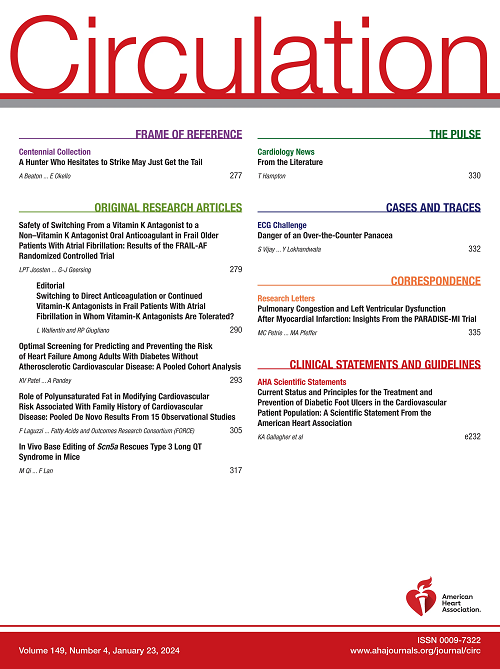Heart Stress and Blood Pressure Management in Older Adults: Post Hoc Analysis of the ASPREE Trial.
IF 38.6
1区 医学
Q1 CARDIAC & CARDIOVASCULAR SYSTEMS
引用次数: 0
Abstract
BACKGROUND Blood pressure (BP) management in older adults is complex because of age-related physiological changes and uncertainty around ideal systolic BP (SBP) targets. Heart stress (HS), defined by age-adjusted elevation in NT-proBNP (N-terminal pro-B-type natriuretic peptide) levels, may improve cardiovascular disease (CVD) risk stratification and support more individualized BP management. METHODS We conducted a post hoc analysis of ASPREE (Aspirin in Reducing Events in the Elderly) involving 11 941 community-dwelling older adults without CVD at enrollment (mean age, 75.1 years; 53.5% women). HS was defined by NT-proBNP ≥150 pg/mL for participants 65 to 74 years of age and ≥300 pg/mL for participants ≥75 years of age. Participants were categorized into 4 groups by hypertension and HS status. The primary outcome was total CVD events (a composite of nonfatal myocardial infarction, fatal or nonfatal stroke, coronary heart disease death, or hospitalization for heart failure). Associations between hypertension and SBP with total CVD events were examined by HS status using Cox proportional-hazards models and restricted cubic spline. SBP was evaluated categorically (<120, 120-129, 130-139, 140-159, or ≥160 mm Hg) and continuously. A landmark sensitivity analysis excluded participants with CVD events or censoring in the first 2 years, with follow-up starting at year 3. RESULTS HS was present in 25.8% of participants. Compared with the reference group (no hypertension or HS), adjusted hazard ratios (95% CI) for total CVD events were 1.41 (1.18-1.70) for hypertension + no HS, 1.79 (1.34-2.39) for no hypertension + HS, and 2.32 (1.89-2.84) for hypertension + HS (Ptrend<0.001). Among participants without HS, the lowest incidence of total CVD events occurred at SBP 130 to 139 mm Hg, showing a U-shaped association across SBP levels (Pnonlinearity=0.011). Among participants with HS, risk increased linearly with SBP (Plinear trend=0.85) and was lowest at SBP <120 mm Hg. Landmark analyses yielded generally consistent findings. CONCLUSIONS HS is common in older adults and jointly associated with hypertension and increased CVD risk. The SBP-CVD relationship differs by HS status, suggesting a potential value of HS for guiding individualized BP management. Prospective studies are warranted to determine whether HS-guided strategies improve BP control and reduce CVD risk in older adults.老年人的心脏压力和血压管理:ASPREE试验的事后分析。
由于年龄相关的生理变化和理想收缩压(SBP)目标的不确定性,老年人的血压(BP)管理是复杂的。心脏应激(HS),由年龄调整后NT-proBNP (n -末端前b型利钠肽)水平升高定义,可能改善心血管疾病(CVD)风险分层,并支持更个体化的血压管理。方法:我们对11,941名无心血管疾病的社区居住老年人(平均年龄75.1岁,53.5%为女性)进行了ASPREE(阿司匹林减少老年人事件)的事后分析。HS的定义为NT-proBNP≥150 pg/mL(65 ~ 74岁),≥300 pg/mL(≥75岁)。根据高血压和HS状态将参与者分为4组。主要终点是总CVD事件(非致死性心肌梗死、致死性或非致死性卒中、冠心病死亡或因心力衰竭住院)。采用Cox比例风险模型和受限三次样条分析高血压和收缩压与总心血管事件的关系。分类评估收缩压(<120、120-129、130-139、140-159或≥160 mm Hg)并持续评估。具有里程碑意义的敏感性分析排除了前2年有心血管疾病事件或筛查的参与者,从第3年开始随访。结果25.8%的参与者存在shs。与对照组(无高血压或HS)相比,高血压+无HS组总心血管事件的校正危险比(95% CI)为1.41(1.18-1.70),无高血压+ HS组为1.79(1.34-2.39),高血压+ HS组为2.32 (1.89-2.84)(p趋势<0.001)。在无HS的参与者中,最低的CVD事件发生率发生在收缩压130 ~ 139 mm Hg之间,在收缩压水平上呈u形相关(非线性=0.011)。在HS患者中,风险随收缩压线性增加(线性趋势=0.85),收缩压<120 mm Hg时风险最低。具有里程碑意义的分析得出了大致一致的结论。结论shs在老年人中很常见,并与高血压和CVD风险增加相关。SBP-CVD关系因HS状态不同而不同,提示HS对指导个体化BP管理具有潜在价值。有必要进行前瞻性研究,以确定hs引导策略是否能改善老年人的血压控制并降低心血管疾病风险。
本文章由计算机程序翻译,如有差异,请以英文原文为准。
求助全文
约1分钟内获得全文
求助全文
来源期刊

Circulation
医学-外周血管病
CiteScore
45.70
自引率
2.10%
发文量
1473
审稿时长
2 months
期刊介绍:
Circulation is a platform that publishes a diverse range of content related to cardiovascular health and disease. This includes original research manuscripts, review articles, and other contributions spanning observational studies, clinical trials, epidemiology, health services, outcomes studies, and advancements in basic and translational research. The journal serves as a vital resource for professionals and researchers in the field of cardiovascular health, providing a comprehensive platform for disseminating knowledge and fostering advancements in the understanding and management of cardiovascular issues.
 求助内容:
求助内容: 应助结果提醒方式:
应助结果提醒方式:


